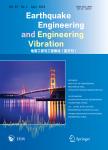Ground motion spatial variability effects on seismic response control of cable-stayed bridges
Ground motion spatial variability effects on seismic response control of cable-stayed bridges作者机构:Civil Engineering Department Faculty of Engineering Assiut University Bridge and Structural Design Engineering Hokkaido University Steel & Composite Structures Kassel Universitt
出 版 物:《Earthquake Engineering and Engineering Vibration》 (地震工程与工程振动(英文刊))
年 卷 期:2011年第10卷第1期
页 面:37-49页
核心收录:
学科分类:070801[理学-固体地球物理学] 07[理学] 0818[工学-地质资源与地质工程] 0708[理学-地球物理学] 0815[工学-水利工程] 0813[工学-建筑学] 0802[工学-机械工程] 0814[工学-土木工程] 0801[工学-力学(可授工学、理学学位)]
基 金:Alexander von Humboldt Fellowship-AvH (IV–AGY/1117497 STP) Japan Society for the Promotion of Science-JSPS Fellowship (P06138)
主 题:cable-stayed bridge vibration control earthquake spatial variation seismic design semi-active control
摘 要:The spatial variability of input ground motion at supporting foundations plays a key role in the structural response of cable-stayed bridges (CSBs); therefore, spatial variation effects should be included in the analysis and design of effective vibration control systems. The control of CSBs represents a challenging and unique problem, with many complexities in modeling, control design and implementation, since the control system should be designed not only to mitigate the dynamic component of the structural response but also to counteract the effects of the pseudo-static component of the response. The spatial variability effects on the feasibility and efficiency of seismic control systems for the vibration control of CSBs are investigated in this paper. The assumption of uniform earthquake motion along the entire bridge may result in quantitative and qualitative differences in seismic response as compared with those produced by uniform motion at all supports. A systematic comparison of passive and active system performance in reducing the structural responses is performed, focusing on the effect of the spatially varying earthquake ground motion on the seismic response of a benchmark CSB model with different control strategies, and demonstrates the importance of accounting for the spatial variability of excitations.



